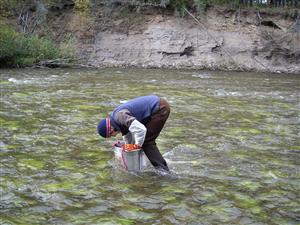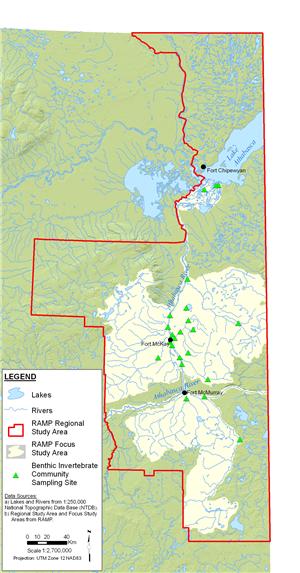Benthic Invertebrate Communities
Benthic invertebrates are organisms that live in or on the bottom sediments of rivers, streams, and lakes. The benthic invertebrate community—the population and species present—is strongly affected by its environment, including sediment composition and quality, water quality, and hydrological factors that influence the physical habitat. Because the benthic community is so dependent on its surroundings, it serves as a biological indicator that reflects the overall condition of the aquatic environment.
The objectives of the RAMP Benthic Invertebrate component are to:
- Collect baseline data to characterize the natural variability of benthic invertebrate communities in the oil sands region.
- Monitor benthic invertebrate communities to identify any changes potentially linked to oil sands development, as well as cumulative effects and regional trends.
- Collect data against which predictions documented in EIAs can be assessed.
Benthic invertebrate communities are monitored in rivers, streams, and lakes throughout the Athabasca oil sands region (see map to the right). Sampling is conducted in the fall of each year to limit variability related to seasonal changes. Supporting environmental data, including flow velocity, water depth, substrate grain size (e.g., percent gravel, sand, etc.), sediment organic matter content, and substrate chlorophyll-a content, are collected at relevant stations in order to separate the effects of natural environmental variability from effects potentially related to oil sands development. Multiple individual samples of surface sediments within a river reach or lake are collected with samplers that remove a known amount of sediment (e.g., the Ekman grab used to sample soft sediments has an area of 15 cm by 15 cm, and thus collects 225 cm2 of sediment). Benthic invertebrate organisms are separated from these samples, identified to the lowest practical taxonomic level, and counted. These data are then used to calculate the following indices or measurement endpoints for each individual sample:
Abundance (total number of organisms/m2). Higher abundance, or density, of organisms is generally seen in systems that are rich in nutrients, while low abundance can be related to short- or long-term toxicity caused by chemicals or by physical disturbance of aquatic habitat.
Taxon richness (the number of distinct taxa per sample). The number of taxa (classifications of organisms, such as species, genus, family, or order) is a measure of community composition; sites with more taxa are generally considered to be in better condition. The number of taxa can increase with moderate nutrient enrichment, but can decrease with excessive levels of nutrients, toxic conditions, or physical disturbance of habitat.
Simpson’s Diversity and Equitability. The Simpson’s Diversity index and equitability are related to the proportion of total organisms contributed by each taxon. Diversity and evenness are low when the benthic community is dominated by a few taxa, and higher when the number of organisms is more evenly distributed across numerous taxa. High diversity and low equitability indicate better environmental conditions, while the opposite can indicate stresses on the system.
EPT Index. The EPT index is a measure of the percent of organisms belonging to the taxa Ephemeroptera (mayflies), Plecoptera (stoneflies), and Trichoptera (caddisflies). These taxa are generally considered to be sensitive to pollution, and high abundance of these organisms can indicate good environmental conditions.
Statistical methods are used to compare these indices between sites, with effects defined as significant differences in indices between baseline and test sites. The ecological relevance of effects is determined by comparing index values to the range of natural variation, determined by pooling results from comparable sites across the oil sands region.
For additional information on the field and analytical methods used in the RAMP Benthic Invertebrate component, please refer to the relevant sections of the RAMP Technical Design and Rationale report and the annual RAMP technical reports (see Monitoring Results). For more general information on benthic invertebrate communities, visit the Aquatic Ecology module.










